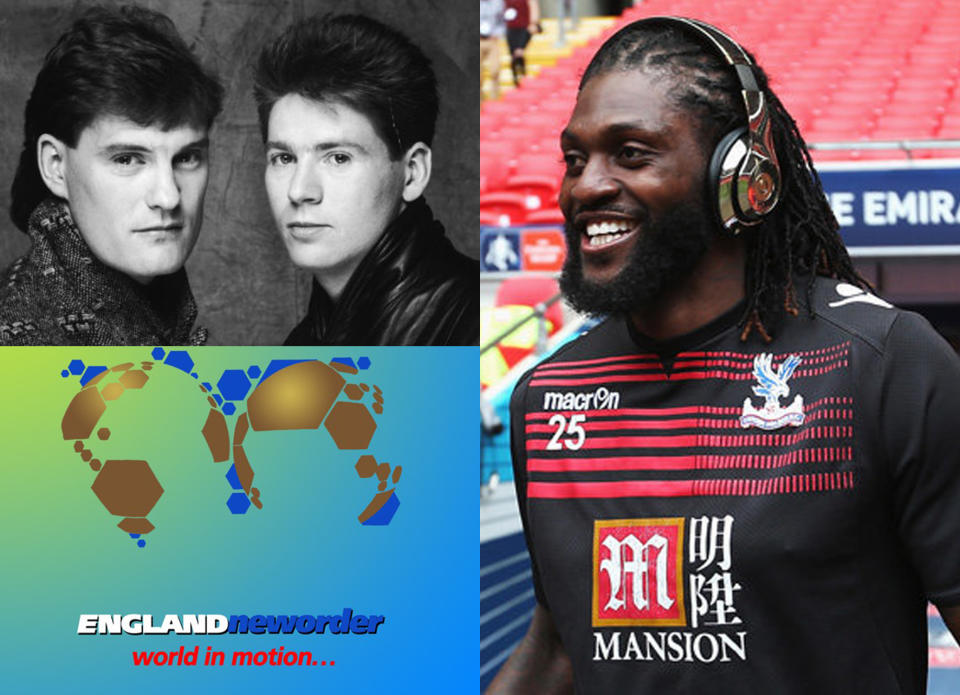Making the game beautiful: The music of Match of the Day, Italia 90 and Emmanuel Adebayor’s Spotify playlist

#8 THE MUSIC
There was a dark period during the early 00s when a gloom enveloped our country. Some consider it the closest that era came to the social, political and existential crisis currently being felt by Brexit. I am, of course, referring not to the “War On Terror” but the rather more disturbing three-year period when ITV won the rights to show The Premier League. It’s a challenge to remember which aspect of their coverage was most poorly received: the 7pm broadcast time, endless commercials or Townsend’s terrible Tactics Truck. But perhaps what really killed it was the music.
READ MORE: Pochettino admits Eriksen may be mentally tired
READ MORE: Who is the new Arsenal kingmaker?
Those of us unfortunate enough to still recall anything about the programme might remember it beginning ultra bombastically with U2’s Beautiful Day. In most living rooms, the absence of the definitive Match of the Day theme tune actually heralded exactly the opposite. Arguably the most distinctive sporting anthem of them all, it was written for the show in 1970 by trumpeter and non-football fan Barry Stoller. His instruction? Write “something good”. Which Stoller certainly managed, creating “a gladiator feel” that remains genuinely iconic to this day. It isn’t, however, the original. That’s Drum Majorette, written by Major Leslie Statham, which was used from 1964 to 1970.
Despite its absence from the actual game, music has a key role to play, particularly pre-match. But what’s the most powerful anthem? The Champions League song? Pah. Not at Carlisle, where they run out to One Step Beyond, Peterborough United (Insomnia) or Tranmere Rovers (Theme From The Rockford Files). Picture the scene in Milton Keys, as MK Dons emerge to the rather fanciful Welcome To The Jungle by Guns N’ Roses. Leyton Orient, meanwhile, have been coming out to Herb Albert’s Tijuana Taxi for nearly 50 years, despite one fan reportedly commenting in 1968: “What’s this got to do with Orient or even football? I can’t see them keeping this for long.”
READ MORE: The football pioneer you’ve never heard of
READ MORE: Murder, manslaughter and Marco Asensio
It’s not just fans that feel the hairs on the back of their neck stand up when the Champions League music strikes up and Heineken adverts begin their hypnotic dance. Even Emmanuel Adebayor, a man largely unmoved by anything other than revenge or the sniff of a few quid, says some players base an entire season’s work on getting into the competition because it has “the best music in my life”. Commissioned by UEFA in 1992, Tony Britten admits he is indebted to another famous composer for the undeniably stirring piece. “It has a kind of Handelian feel to it but I like to think it’s not a total rip-off,” he noted, perhaps overestimating the average fan’s knowledge of classical music just a touch.
There was a period between 1970 and the end of the 90s when it actually became oddly fashionable for football clubs to release their own singles to soundtrack a potential triumph. Did this really happen? Yes. Who could forget Ossie’s Dream, Three Lions or Glasgow Rangers (Nine In A Row)? Strangely, many of these anthems deployed brackets to get their clumsy message across. Consider Ole Ola (Mulher Brasileira), This Time (We’ll Get It Right), Liverpool (We’re Never Gonna…), Anfield Rap (Red Machine In Full Effect), United (We Love You), Move Move Move (The Red Tribe) and Pass & Move (It’s The Liverpool Groove).
But were any of them actually good? No. With the exception of New Order’s Italia 90 World Cup anthem World In Motion, a truly sublime slice of electronic pop which elevated football into a realm of cultural credibility it’s unlikely to ever again attain. It helped that John Barnes, a man with considerably more skill as a rapper than a manager, made such a convincing contribution. Footballers venturing into music rarely seems a good idea, particularly when we’re actually supposed to take them seriously. Glenn Hoddle, for example, sang on five UK top 20 hit singles between 1981 and 1987, and will surely be made aware of the chart atrocity he committed in a previous life with Chris Waddle upon reincarnation.
READ MORE: Football skills that defy science
READ MORE: The virtual reality of David Luiz
Many national teams have also traversed the tricky terrain between football pitch and recording studio with not even close to mixed results. Iran’s mildly troubling 2006 Eurodance abomination Immortal Iran is only made slightly less unsettling by the appearance of a translucent violin for an improbable solo. But Germany’s USA 1994 collaboration with The Village People really takes some beating, particularly when you learn that the squad were such big fans of the band that they reportedly insisted on staying at a YMCA in Boston during the competition. What’s next? Well, it seems Frank Ribery might be poised to follow Andy “Andrew” Cole into music when retirement hits.
Ribery updates fans on his injury while looking like he's about to drop a new rap album 😂 pic.twitter.com/YG3wYctO0S
— 101 Great Goals (@101greatgoals) October 4, 2017
The stars of football and music have also occasionally aligned in more authentic, less obvious ways, which are not so easy to dismiss. Strachan by The Hitchers draws a near poetic comparison between football and art. Lars Vaular, reputedly Norway’s leading rapper, name-checks much of the Leeds 2000 squad in a vibrant terrace anthem tribute to Gary Speed. But it’s hard to look beyond The Fall’s Theme From Sparta FC to find a genuinely arresting, swaggering ode to the sport. Singer Mark E Smith is, of course, a man with an intrinsic insight into what makes this “the beautiful game”, having somehow convinced the BBC to let him have a go at the classified football results live on-air in November, 2005.
NEXT WEEK: THE BEST GOALS

 Yahoo Sport
Yahoo Sport 






































